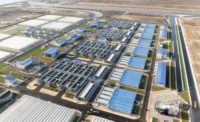The International Atomic Energy Agency says Japan’s plan to slowly discharge more than 1 million cu meters of treated water from the destroyed Fukushima Daiichi nuclear power plant into the sea appears to align with international safety standards, with impact on the local community and environment seen as “negligible.”
But the agency will work with the Japanese government to monitor discharges over time to corroborate its findings, it said in a comprehensive July 4 safety analysis of the plan to address the rapidly accumulating levels of contaminated water stored at the plant—which was shut down after a March 2011 earthquake and subsequent tsunami caused partial meltdowns in three of its reactors, explosions and release of radioactive material.
Continued onsite monitoring will “ensure the relevant international safety standards continue to be applied throughout the decades-long process,” said IAEA Director General Rafael Mariano Grossi in a statement.
The government of Japan and plant operator Tokyo Electric Power Co. (TEPCO) requested the agency analysis after releasing its plan in April 2021 to discharge formerly radioactive water stored at the plant. Since the accident, TEPCO has used water to keep melted fuel at the site cool. Additionally, groundwater and rain have seeped into the damaged reactor and turbine buildings. Water becomes contaminated whenever it comes into contact with melted fuel and other radioactive substances, and needs to be either stored safely or treated and discharged.
Japan's Discharge Plan Has Opposition
TEPCO has treated more than 1.3 million cu meters of water, storing in about 1,000 containers onsite using an advanced liquid processing system developed by start-up Kurion and Veolia, which acquired Kurion in 2016. The pumping and filtration system uses processes that remove 62 radionuclides through a series of chemical reactions. However, the system is unable to remove tritium, a naturally occurring radioactive hydrogen isotope, with no technology available that can remove it at the scale needed at Fukushima.
Japanese environmental and community groups, as well as the governments of China and South Korea, have criticized Japan’s plan because the water will contain some level of radioactivity. But Paul Dickman, an advisor to Japan on the decommissioning of Fukushima and a member of the American Nuclear Society, notes that the amount of tritium that will be discharged into the water is well below regulatory limits in Japan. He says nuclear power plants around the world routinely discharge diluted levels of tritium into bodies of water.
TEPCO plans to release wastewater diluted to concentrations of 1,500 becquerels of tritium per liter of clean water, well below the 60,000 becquerel limit in Japan. “Really, it’s not a technical issue. It’s a political issue,” Dickman says.
The rate of tritium release could actually be higher because it will take decades at current levels, says Dickman. “They need to clear the land of these tanks to [be able to] build the facilities they need for decommissioning the reactors,” which in their current state pose a greater risk than minute levels of tritium in the water, he says.
TEPCO awarded a five-year contract to Jacobs last year to provide program and project management support, as well as long-term decommissioning strategy planning.
Edwin Lyman, director of nuclear power safety at the Union of Concerned Scientists, notes that the length of time it will take for contaminated water to be removed from the site poses a risk of its own. If there was another earthquake or other natural disaster, he warns there is "the risk of an uncontrolled release” of contaminated water at much higher levels. “Unfortunately, with the situation we are in, [all of] the options are less than desirable,” Lyman says.
The IAEA report is non-binding. In its introduction. Grossi noted that the decision to release treated water stored at the power plant is "a national decision by the Government of Japan and that this report is neither a recommendation nor an endorsement of that policy."
Japan's Nuclear Regulation Authority approved the plan in May.





